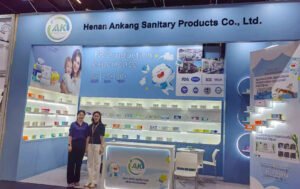What ARE the Best Dog Grooming Wipes? An Insider’s Perspective from Ankang
Life with our furry companions is messy, magnificent, and often requires a quick cleanup solution! Between muddy paws after a walk, or simply keeping faces fresh between baths, dog grooming wipes have surged from convenience to canine care essential. But here’s the sudden jolt – not all wipes are created equal. As a manufacturer deeply embedded in the world of hygiene and pet wellness at Ankang, I see the confusion firsthand. Walk down any pet aisle, browse online, and you’re bombarded with choices. “Natural!” “Hypoallergenic!” “Deodorizing!” How do you, the devoted pet parent, cut through the noise and find the truly best dog grooming wipes for your unique four-legged family member? That’s precisely the puzzle we aim to solve today, drawing back the curtain on what matters most from the perspective of those who formulate and craft these products.
Beyond Convenience: Why Dog Grooming Wipes Are a Modern Must-Have
Think of a quality dog wipe as your Swiss Army knife for canine cleanliness. It’s not just about avoiding a full bath (though that’s a huge perk, especially on cold days or with bath-averse pups!). It’s about:
- Targeted Tidy-Ups: Quickly clean muddy paws before they track through the house. Gently wipe away tear stains or sleepies from sensitive eyes. Freshen up the coat after a playdate or before a cuddle session. Address the “back end” after potty breaks with specialized wipes.
- Maintaining Skin & Coat Health: Regular gentle wiping can help remove surface dirt, allergens, and loose hair that might otherwise lead to irritation or matting. It distributes natural oils for a healthier sheen.
- Sensitive Skin & Puppy Care: For very young puppies who aren’t ready for baths, senior dogs with mobility issues, or pups with sensitive skin conditions, gentle wipes can be a lifesaver for maintaining hygiene without stress.
- Odor Control On-the-Go: Neutralize that unmistakable “wet dog” smell or other minor odors between baths, keeping your pup (and your car or furniture) fresher.
But here’s the crucial pivot: Convenience should NEVER compromise safety or effectiveness. That’s where understanding what defines the “best” becomes paramount.
Decoding the “Best”: Non-Negotiable Features of Top-Tier Dog Wipes
At Ankang, formulating a product we’d confidently use on our own pets means adhering to rigorous standards. Forget the marketing fluff; here’s what genuinely matters when evaluating dog grooming wipes:
1. Ingredient Integrity: Safety First, Always
- Gentle, Non-Toxic Cleansers: Harsh sulfates (SLS/SLES), parabens, alcohol (ethanol, isopropyl), phthalates, and artificial dyes are absolute red flags. These can strip natural oils, cause dryness, irritation, and even systemic toxicity if ingested during grooming (which happens!). Look for plant-derived, biodegradable cleansers.
- Hypoallergenic Formulations: Prioritize wipes free from common allergens like fragrances (even “natural” ones can irritate), dyes, and known harsh chemicals. “Fragrance-free” is often safest for sensitive pups. If scent is used, it should be minimal and derived from essential oils known to be safe for dogs (like lavender or chamomile, in appropriate dilution), not synthetic perfumes.
- pH Balanced for Canine Skin: This is critical and often overlooked! Human skin pH is around 5.5, but dogs sit closer to neutral, typically between 6.2 and 7.4. Using wipes formulated for human pH can disrupt the dog’s delicate acid mantle, leading to dryness, itchiness, and vulnerability to infections. The best wipes are explicitly pH balanced for dogs.
- Moisturizing & Soothing Agents: Look for ingredients like Aloe Vera, Vitamin E, Oat Extract, Coconut-derived cleansers, or Chamomile. These help counteract any drying effect of cleansing and soothe the skin.
- Natural Preservatives: Wipes need preservation to prevent bacterial and fungal growth. Opt for brands using safer, broad-spectrum preservatives like Sodium Benzoate, Potassium Sorbate, or Benzyl Alcohol over more controversial ones like MIT (Methylisothiazolinone) or formaldehyde-releasers.
2. Effectiveness: They Need to Actually Work!
- Cleaning Power: The wipe must lift dirt, mud, and light grime effectively without requiring excessive rubbing. The texture of the cloth matters – it needs some “grip” but be soft enough not to scratch.
- Deodorizing Ability: Does it genuinely neutralize odors (enzymatic action or odor-trapping ingredients) or just mask them with a stronger fragrance? True odor control is a sign of a well-formulated wipe.
- Cloth Quality: Flimsy wipes that tear easily or feel rough are frustrating and ineffective. Look for durable, generously sized, soft non-woven fabrics (preferably plant-based like viscose or bamboo) that feel comfortable against your dog’s skin. Thickness and moisture content per wipe are also key indicators of quality.
- Residue-Free: Does it leave a sticky or greasy film? The best wipes clean effectively and evaporate or absorb cleanly, leaving the coat feeling fresh, not tacky.
3. Purpose-Driven Formulations: One Size Does Not Fit All
The “best” wipe for your dog depends heavily on why you need it. Confusion reigns when a generic wipe fails a specific task. Look for specialized options:
- All-Purpose/Body Wipes: General cleaning, good for paws, body, and light freshening. Should be the most gentle and versatile.
- Paw & Pad Wipes: Often slightly tougher to remove mud and grit, may include extra moisturizers for cracked pads, and sometimes offer stronger deodorizing for “Frito feet.”
- Tear Stain & Face Wipes: MUST be tearless, extra gentle, often fragrance-free, and specifically formulated for use near delicate eyes. Look for soothing ingredients.
- Deodorizing/Bath Alternative Wipes: Designed for a more thorough freshening, often larger and more textured. May contain specific odor-neutralizing complexes.
- Sensitive Skin/Hypoallergenic Wipes: Minimalist ingredient lists, fragrance-free, dye-free, and rigorously tested for low irritation potential.
- Puppy Wipes: Ultra-gentle, often tearless and suitable for overall use on very young, sensitive skin. Ingredient safety is paramount.
4. Ethical & Practical Considerations
- Eco-Consciousness: Biodegradable cloths and plant-based fibers (like bamboo or wood pulp) are preferable. Packaging should be recyclable where possible. Consider wipes designed to be flushed (ONLY if certified flushable and your sewer system allows) or compostable. At Ankang, we constantly explore sustainable innovations.
- Value & Packaging: Are you getting enough wipes per pack? Is the packaging resealable and robust enough to prevent the wipes from drying out? Flip-top lids are generally more effective than sticker seals over time.

Navigating the Minefield: Common Pitfalls When Choosing Wipes
Confusion often stems from well-meaning but misguided choices:
- “But These Baby Wipes Are Cheaper!”: This is perhaps the most common and potentially harmful misconception. Baby wipes are formulated for human infant skin pH and needs. They often contain fragrances, lotions, and preservatives unsuitable for dogs, and their pH imbalance can wreak havoc on canine skin. Never substitute baby wipes for dog wipes.
- Overlooking the Ingredient List: Don’t just trust the front label claims. Flip it over! Scan for the red-flag ingredients mentioned earlier. If the list is long, full of unpronounceable chemicals, or lacks key beneficial ingredients, reconsider.
- Assuming “Natural” or “Organic” Means Safe: While generally positive, these terms aren’t regulated in pet products like they are for humans. A “natural” fragrance can still be an irritant. Focus on the specific ingredients and overall formulation safety.
- Ignoring Your Dog’s Individual Needs: A wipe perfect for a Lab’s muddy paws might be too harsh for a Yorkie’s face or a Bulldog’s sensitive skin folds. Match the wipe to the purpose and your dog’s unique physiology.
- Over-Wiping: Even the best wipes aren’t a daily full-body substitute for baths. Overuse, especially on sensitive areas, can lead to irritation. Use them for targeted cleaning as needed.
The Ankang Difference: Our Philosophy in Every Wipe
As a manufacturer committed to both human and pet wellbeing, our approach to crafting dog grooming wipes is rooted in responsibility:
- Veterinary Consultation: We collaborate with veterinary professionals to ensure our formulations meet safety and efficacy standards for canine health.
- Rigorous Ingredient Vetting: Every component undergoes scrutiny for safety, gentleness, and environmental impact. We prioritize globally approved, skin-friendly ingredients.
- pH is Paramount: Our wipes are meticulously pH balanced specifically for canine skin to support its natural protective barrier.
- Hypoallergenic Focus: We formulate many lines to be fragrance-free, dye-free, and minimize common irritants, understanding how prevalent sensitivities are.
- Durability & Feel: We select high-quality, soft non-woven fabrics that are durable, generously moistened, and feel soothing against your dog’s skin.
- Sustainable Mindset: We actively invest in research for more biodegradable materials and eco-responsible packaging solutions, because loving pets means loving the planet they live on.
Choosing YOUR Champion: A Practical Guide
Armed with this knowledge, how do you select the best wipes for your dog? Follow this roadmap:
- Identify the Primary Need: Is it paws? Face? General freshening? Sensitive skin? Start by narrowing the type.
- Scrutinize the Ingredients: Flip that package! Avoid red flags. Look for beneficial, gentle ingredients and pH balancing statements.
- Consider Your Dog: Breed, coat type, age, and known sensitivities are crucial. A thick-coated dog might need a more textured wipe; a puppy or sensitive breed needs the gentlest option.
- Check Cloth Quality & Size: Feel the sample if possible (many brands have display windows). Ensure it feels soft and substantial.
- Evaluate Eco-Credentials: Look for biodegradable materials and recyclable packaging if sustainability is a priority for you.
- Trust Reputable Brands: Choose companies known for pet safety and transparency. Look for GMP (Good Manufacturing Practice) or ISO certifications as signs of quality control (like those adhered to at Ankang).
- Patch Test: Especially for sensitive dogs, test a new wipe on a small area (like the inner leg) and wait 24 hours for any reaction before widespread use.
Beyond the Wipe: Best Practices for Use
Even the best wipes need proper handling:
- Avoid Eyes & Inner Ears: Unless explicitly formulated and labeled as “tearless” for faces, keep wipes away from direct contact with eyes and the inner ear canal. Use a soft, damp cloth for these ultra-sensitive areas.
- Gentle Motion: Wipe gently in the direction of hair growth. Don’t scrub harshly.
- Discard Properly: Do not flush unless explicitly certified AND safe for your sewage system. Most belong in the trash. Consider compostable options if available and suitable.
- Store Correctly: Keep the package tightly sealed to prevent drying out.
- Monitor Your Dog: If you notice any redness, itching, or discomfort after use, discontinue immediately and consult your vet.
The Final Rub: Seeking the Truly Best for Your Best Friend
The quest for the best dog grooming wipes isn’t about finding a single magic product. It’s about understanding the intricate balance between safety, efficacy, and your dog’s individual needs. It requires looking past flashy marketing and delving into the substance – the ingredients, the pH, the cloth quality, and the brand’s commitment to genuine pet wellness. Confusion is natural in a crowded market, but knowledge is your most powerful tool.
At Ankang, we believe your dog deserves the same level of thoughtful, safe hygiene solutions that you expect for your own family. We formulate our wipes with that profound responsibility in mind – striving to create products that cleanse effectively, soothe gently, and protect the precious bond you share with your canine companion. When you choose wisely, those convenient little sheets become more than just clean-up tools; they become an expression of love and care, ensuring every adventure, big or small, ends with comfort and a fresh start.
FAQs
- Q: Can I use human baby wipes on my dog?
A: We strongly advise against it. Baby wipes are formulated for human infant skin (different pH) and often contain fragrances, lotions, and preservatives that can irritate canine skin or be harmful if licked. Always use wipes specifically designed and pH-balanced for dogs. - Q: How often can I safely use dog grooming wipes?
A: Moderation is key. For targeted areas like paws or undercarriage after walks, daily use is generally fine with a high-quality wipe. For full-body freshening, limit it to once or twice a week maximum, as overuse can disrupt natural skin oils. Always monitor your dog’s skin for any signs of irritation. - Q: Are “natural” or “organic” dog wipes always better?
A: While generally positive trends, these terms aren’t strictly regulated in pet products. Focus primarily on the specific ingredient list and safety profile. A “natural” ingredient can still cause allergies. Look for hypoallergenic formulations, pH balancing, and the absence of known harsh chemicals, regardless of the “natural” label. - Q: My dog has very sensitive skin. What should I look for?
A: Prioritize fragrance-free, dye-free, alcohol-free wipes explicitly labeled “hypoallergenic” and “for sensitive skin.” Look for minimal ingredient lists featuring soothing agents like Oat Extract, Aloe Vera, or Chamomile. Ensure they are pH balanced for dogs. Always patch test a new wipe on a small area first. - Q: Are dog grooming wipes environmentally friendly?
A: Traditional wipes can contribute to landfill waste. Look for brands committed to sustainability: biodegradable cloths (bamboo, wood pulp, viscose), plant-based fibers, recyclable packaging, and certifications for flushability (use with caution and check local guidelines) or compostability. While no wipe is perfect, choosing eco-conscious options significantly reduces environmental impact. At Ankang, sustainable innovation is a core focus.





